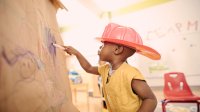A Preschool Teacher Reflects on a Three-Decade Career
A National Teachers Hall of Fame inductee on why getting parents and guardians involved in their kids’ earliest school experiences has always been key.
Your content has been saved!
Go to My Saved Content.Since the onset of the pandemic, many preschool teachers have worked hard to support families in fostering powerful learning opportunities at home. That’s a big ask of busy parents who aren’t trained as teachers, but it’s a necessity—kids that age can’t be self-directed for long, and they need rich play experiences that develop their imagination and speaking and listening skills, and solidify concepts from math and science. Play is also a chance to explore mistakes: Why did that block tower fall down? What would make it more stable?
And when parents and caregivers get involved in their preschool-age kids’ learning, research shows, it’s the number one predictor of early literacy success and academic achievement in later grades. “One of the biggest mistakes I made in my career, early on, was not involving the families in my work,” said Rebecca Palacios, who was a preschool teacher for more than three decades and received the National Teachers Hall of Fame award from Emporia State University in 2014.
Palacios spoke with Kristina Rizga at The Atlantic for an interview that’s part of the powerful On Teaching series, an effort to gather the wisdom of veteran educators.
Partnering With Families
Eager to get parents involved in their children’s language acquisition, Palacios and her teaching partner applied for a grant to start a lending library. “Some parents were Spanish speakers; some of them were English speakers,” Palacios told Rizga. “As teachers, we only had the children for three hours; then they went home, and they didn’t have a rich print environment.” The effort to build a library paid off: Being able to send home books and audiobooks—cassette tapes and a tape recorder in those days—was key to boosting the kids’ language skills. “We did a pre- and post-test, and our scores were through the roof,” Palacios recalled.
Being able to look back over several decades means that Palacios has a clear sense of how preschool education has changed recently. She sees many difficulties facing preschool teachers today, including teachers working two jobs to make ends meet, and a top-down style of school leadership that stands in stark contrast to the more collaborative partnerships Palacios had with principals when she was starting out.
Deep budget cuts, Palacios noted, have created a heavier workload for teachers—since the ratio of students to teachers is higher—and a lack of necessary classroom learning materials. “The district used to provide a little pool of money, and sometimes it was $200 a year, but it really helped me to buy consumables, like paint, crayons, seeds, and play dough,” Palacios said. “You need a lot of materials for language experiences. You have to bring in these things that they can roll, touch, play with, cook, eat, and smell.”
The Value of Using Themes in Teaching
In addition to involving families more, another fundamental shift Palacios made in her teaching practice was to redesign her curriculum to seamlessly combine “multiple subject areas into a very visual, oral, tactile, thematically integrated lesson environment.” Her approach as a novice teacher had been “more splintered and not as engaging to children: Now it’s reading time; now it’s math time; now it’s science time,” she said.
Once she learned to integrate subjects and produce more lively, engaging lessons for her students, taking on a theme like farms, for example, became an opportunity for expansive learning, building on prior knowledge that would help students with every subsequent lesson: “As we were learning about families living on a farm, we would integrate math by learning about the shapes of the buildings on a farm: the silo, the triangles in front of the barn door,” Palacios said. “We would teach seasons of the year as science, as well as the life cycle of animals on a farm, and how the farmer prepares, plants, and rotates crops. And then for social studies, we would explore the farmer’s job [and] farm-to-market systems.”
At every stage, Palacios told Rizga, “you are developing vocabulary and literacy. The more a teacher integrates subjects thematically, the more she can review and reinforce similar concepts over time.”
And in the end, Palacios said, that method of teaching thematically best suited her overall goals in the classroom: “I felt my job was to build reading, math, science, social studies, art, and music into engaging learning experiences that helped the child develop vocabulary and made them want to come to school.”
